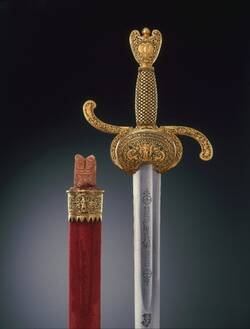Late Renaissance ceremonial weapons form the largest part of the Dresden Armoury collection. In addition to pistols and armour for horsemen and their mounts, the collection also features weapons used in close combat, including rapiers, daggers, epees and swords. Duke Johann Georg Casimir of Saxony-Weimar gave the epee you see here to Elector Johann Georg I in January 1620, probably to mark a particular event in the Thirty Years‘ War. The Imperial double eagle on the hilt suggests this connection.
When Johann Georg I came to power, he adopted a moderate Lutheran position in the conflict between the Catholic League and the Protestant Union. In fact the Elector of Saxony played a significant role in the political turmoil that preceded the outbreak of the Thirty Years‘ War. As Imperial Vicar he successfully mediated between the Catholic and Protestant groups in 1612, and in 1617 he welcomed the Catholic Emperor to Dresden, along with his potential successor Ferdinand. That was an important diplomatic gesture. Saxony was the most powerful Protestant territory in the empire, and by inviting the Emperor to Dresden he was tacitly recognising the Catholic Habsburg ruler. However, diplomat that he was, Johann Georg also later staged a celebration to mark the first centenary of the Reformation.
Just below the guard, you can see a figure: a semi-naked, miniaturised, muscular fellow seems to be on watch there. He’s carrying a club over his shoulder, and if you’re familiar with Greek mythology, you’ll immediately recognise him as Hercules, the strongman of the ancient world.
References to mythological heroes and to Greek and Roman gods abound in Renaissance culture. The nobility, with its claims to power, especially appreciated allusions of that kind. Anyone referred to as a Hercules would enjoy his moment of reflected glory.
The hilts of epees, rapiers and daggers were often decorated with heroic, classical figures.
The motto Soli Deo Gloria, “To God alone the Glory”, is engraved on the blade. This dedication was popular in the Early Modern Era. Johann Sebastian Bach, for instance, inscribed the last page of many of his compositions with these words – or with the abbreviation, S D G.
